Final report for FNC16-1027
Project Information
We raise grass-fed bison on 320 acres of pasture in central Nebraska. We are certified grass-fed and grass-finished and also animal welfare approved which means we cannot supplement with any grain, spray the pastures with chemicals, or treat the animals with hormones or subtherapeutic antibiotics. It also requires humane slaughter which is accomplished on-farm. The pasture is divided into 16 paddocks and the bison are rotated through them throughout the summer. All the animals (males, females, calves of all ages) are kept together as a herd year-round. Income comes primarily from selling the meat to retail and wholesale customers from a mobile store.
The problem addressed was insufficient income from the ranch to compensate for owners’ labor. The proposed solution was to increase profits by increasing soil fertility and water holding capacity to increase animal productivity. The research approach involved applying three different natural additives to three areas of the pasture and leaving a fourth area untreated to serve as a control area. The three additives were: 1) a biological solution of fish emulsion, raw milk and a little molasses; 2) sea minerals; and 3) a product called GroPal Balance which is a combination of biological solution and sea minerals. Soil tests were conducted at the beginning of year 1 and year 2 and at the end of year 2 (for the 2-year project).
The soil tests initially showed an improvement in the organic matter and overall soil health of the treated areas. The final test, however, showed improvement in all areas, including the control area. This may have been due to the rotational grazing which has been practiced on this pasture for the past 5 years. There does seem to be an increase in productivity of the pasture as a whole when comparing calf crops and slaughter weights. Two years, one with good rainfall and the second with poor rainfall and other production challenges, is hardly enough to prove the success or failure of the practices employed and the farmers will continue monitoring and evaluating the effects of these additives. Overall, the farmers plan to continue with applying the GroPal Balance due to the ease of use. Sea minerals will continue to be offered as a mineral supplement.
Compare soil health of pasture as measured by soil tests, visualization and soil aggregates in areas where 1) no additive is applied, 2 ) a biological solution is applied, 3) sea minerals are applied, or 4) a combination product is applied.
Cooperators
Research
Year 1: Beginning in March, we visited with personnel from Ward Lab (Kearney, NE) about our plans and got their advice on how best to collect soil samples and what tests to run. A soil probe was purchased and samples were collected and compiled to have a composite sample from each of the 4 test areas. These were sent to Ward Lab and we received a biological soil analysis report (Haney Soil Health Analysis) for each of the 4 areas. During March and April we were also purchasing our soil amendments: GroPal Balance from AgUSA, Sea 90 sea minerals from an area distributor, fish emulsion from Green Pastures, and raw milk from area milk producers. We also purchased a Brix meter to test for sugar content in the grass.
May was spent applying the additives. The pasture has 16 different paddocks and 4 were assigned to each of the 4 test areas (1 test area for each of the additives and 1 for control.)
Throughout the summer the bison were rotated through the various paddocks for grazing.
In July we purchased equipment to do a Solvita test in each of the 4 treatment areas. (This is a measure of CO2 respiration which reflects biological activity.) Several soil samples were again collected and compiled to have 1 test from each of the 16 paddocks. The results were read by comparing the test strip to the color chart; using a meter would have given more exact measurements. An attempt was made to get Brix readings on the grasses from each area but it proved to be too difficult to get enough sap to get an accurate reading.
Year 2: Soil samples were collected from each of the 4 test areas. During June each area was treated with the same additives as the previous year. The biological solution and sea minerals were applied at the same rate as in the first year; the GroPal Balance was applied at half the rate according to instructions. In addition, a test strip, which was fenced off from grazing, was mowed to simulate grazing. Then each of the 3 additives were applied in marked areas with the 4th area left untreated as a control. This was done in an attempt to compare side-by side results. (Unfortunately, growing conditions were such that there was very little regrowth in any of the areas.) Solvita tests were taken on test areas on Aug. 1 and again in October. These results were read with a meter to get more accurate readings. (It should be noted that these readings were taken in the field and cannot be compared to readings from a lab analysis. They are only for comparison to each other. The higher the scores the greater the CO2 respiration, reflecting higher biological activity in the soil. )
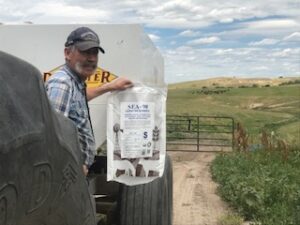
Sea minerals were applied using a dry fertilizer applicator
.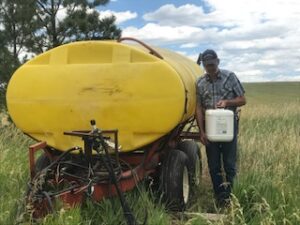
The combination product (GroPal Balance) was easy to mix in the sprayer tank and apply to pasture.

The fish emulsion, raw milk, and molasses had to be mixed in another tank before being added to the sprayer tank, which took extra time. Filtering helped reduce the plugging of the sprayer nozzles.
Impacts
Project Results and Lessons Learned
Year 1: We learned there is a difference in the ease of obtaining and putting on the applications. The Gro-Pal Balance was easy to order, have shipped and arrived in a 5 gallon bucket which was enough for 2 years. It was easy to mix in water and spray on with liquid sprayer. The Sea-90 came in 50 lb. sacks, of which we bought 40. We were able to pick these up at a location 140 miles from home. It did not mix easily in water so we put it on with a dry fertilizer applicator. The rains which followed allowed it to dissolve into the soil. The biological solution involved making several trips to a couple of dairies to collect enough raw milk which was destined for dumping. Since not all the milk could be obtained at one time, the milk was kept frozen until ready to use to prevent it from clabbering. This was then added to liquid fish emulsion which we obtained in a 55 gallon barrel, picked up at the same time we picked up the Sea-90. These were mixed and put on with a liquid sprayer with occasional plugging of the nozzles.
It was difficult to say at the end of year 1 what effect each of the treatments had on biological activity of the soil, grass production, the health of the animals and economic benefit to the producer. There were good rains throughout the summer which resulted in more grass growing in all areas of the pasture. We did not see a visual difference in the grass between the areas of treatment .There was definitely more grass left at the end of the grazing season in all areas but how much of this was due to applications of soil amendments and how much was from increased rainfall was unknown.
The Solvita test conducted in July showed the following results: Control area: 4.5, Biological solution: 5.0 Sea minerals and GroPal Balance: 4.9. It would appear from these readings that the biological solution (fish emulsion & milk) had the greatest benefit.
Economic Impact: The bison had sufficient grass to continue grazing without any supplemental hay up to January 2017 at which time we began feeding at an average rate of 8-9 lb. /head/day.
In 2016, 21 calves were born from 26 cows; 4 died (1 had been born blind) and 17 were raised. This is an 81% live calf rate and 65% weaned rate. This mostly reflects the health of the animals prior to treatment of the pasture since the treatments were not started until after most of the calves had been born. Twenty-four animals were harvested with a total weight of 10,430 lb. hanging weight, average 434.5 lb./ animal.
Work plan
Plan at the end of year 1: Soil tests will be repeated in the spring and summer. Each of the treatments will be repeated in 2017 in the same areas as in 2016. We will try again to get Brix readings on the grasses.
Another plan to see a comparison in treatments was to do a side-by-side comparison of applications in an area that is fenced off from grazing. This is an area where about 300 shrubs were planted 10 feet apart in 2 rows, with about 15 feet between the rows. Since the soil and grass is fairly uniform in this area and no grazing is occurring, it should have been fairly easy to see any differences in treatment areas.
Outreach
We did not have any field days or demonstrations in year 1.
Research results year 2:
By October 2017 the pastures looked very bleak. There had been almost no regrowth of the grass after the initial grazing. This is not what we had hoped to see for the conclusion of this study. However, when we looked beneath the surface at the numbers, it was not as bad as it seemed.
The pastures looked good beginning in April. Then 10 inches of snow May 1, another 6 inches May 20 looked like a good store of moisture. However, it may have cooled the soil enough that it slowed grass growth instead of helping it. No rain in June, then a hailstorm with baseball-sized hail on July 3 may have further contributed to slowed growth. With no further rains in July, and heavy grasshopper infestation, by August 1 the pastures were eaten down and beginning to look brown. During the first 2 weeks of August a couple rains totaling about 4 inches brought the green color back but there was not significant growth. By August we began feeding hay to the bison to take pressure off the pastures. The annual harvest of meat animals was also moved from October to September to limit the amount of hay that needed to be purchased. Even the test strip that had been mowed in early June showed almost no regrowth of grass even into late fall.
Solvita test Aug. 1, 2017, (hot, dry soil), using a meter to read results: Control: 12.42; biological solution: 27.2; sea minerals: 18.9, GroPal Balance: 18.5. Again, the biological solution shows the best biological activity in the soil. However, there was no visual difference between the areas.
Solvita test Oct. 29, 2017, (cool, damp soil) using a meter to read results: Control: 4.94; biological solutions: 5.20; sea minerals: 4.17; and combination product: 4.84. The biological solution once again shows the best results, with the control being higher than the other 2 treated areas.
Accomplishments
Activities:
Year 2:
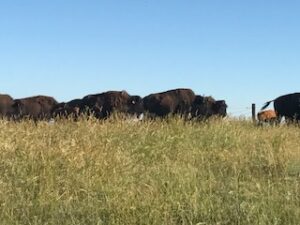
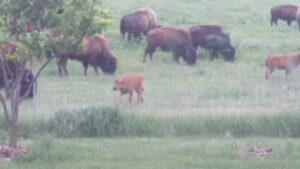
Pastures looked good in April and May 2017
.
Late snowstorms probably cooled the ground and slowed growth.
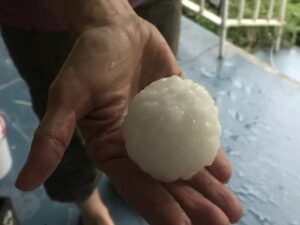
July 3 hailstorm also set the pastures back
.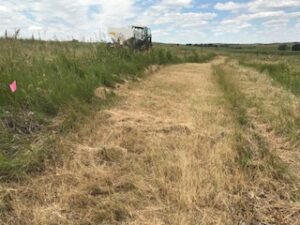
This test plot was mowed in June and treated with each of the soil amendments, leaving 1 area for control.
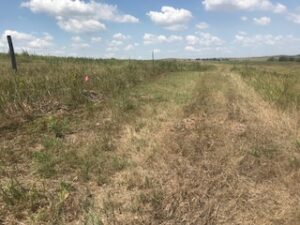
Aug. 1 there was no regrowth in any of the areas
.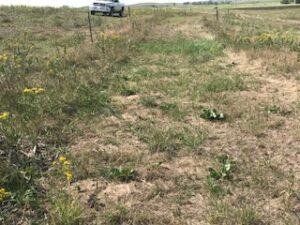
After August rains there was some greening but little regrowth by October.
So what did we learn from this experiment?
The following is a chart of the significant information obtained from soil tests done in April 2016 (before the application of any soil amendments), May 2017 (after the first year’s applications), and Dec. 2017 (after the second year’s applications).
|
Test Date of test |
Treat. 1 (Biol. Sol’n ) |
Treat. 2 (Sea Minerals) |
Treat. 3 (Combo) |
Treat. 4 (Control) |
|
Organic Matter % |
|
|
|
|
|
4/16: |
2.9 |
2.9 |
3.1 |
3.1 |
|
6/17: |
3.4 |
3.4 |
3.6 |
3.6 |
|
12/17: |
3.7 |
3.7 |
4.2 |
3.6 |
|
CO2-C Respiration (Solvita test) ppm C |
|
|
|
|
|
4/16 |
134 |
102 |
128 |
113 |
|
5/17 |
155 |
141 |
162 |
141 |
|
12/17 |
202.3 |
226.3 |
205.3 |
225.1 |
|
Soil Health Calculation |
|
|
|
|
|
4/16 |
13.76 |
12.09 |
14.99 |
13.33 |
|
5/17 |
17.07 |
16.34 |
16.06 |
13.68 |
|
12/17 |
21.49 |
22.36 |
21.03 |
22.16 |
|
Cover Crop Suggestion (% legume/%grass) |
|
|
|
|
|
4/16 |
40/60 |
50/50 |
40/60 |
40/60 |
|
5/17 |
30/70 |
30/70 |
30/70 |
40/60 |
|
12/17 |
20/80 |
20/80 |
20/80 |
20/80 |
|
Cost of Treatment for 2 years |
$1214 + transportation to collect milk |
$1940 |
$2007 |
$0 |
As can be seen, the soil improved in all these areas. The apparent advantage of the biological solution seen in the field Solvita tests is not as clearly seen in these results. The control areas also improved making one wonder if the treatments were of any value. The improvement in the control areas is probably due to the pasture rotational grazing. We have been practicing rotational grazing for about 4-5 years. The soil amendments appear to have speeded up the soil improvement by showing a larger increase in the treated areas after the first year of treatment.
Another indication of improved soil health was in the tilth of the soil. This could be seen in the root structure of plants dug and the ease with which a trowel could be inserted into the soil. Overturned manure piles probably indicated increase beetle activity in the soil.

Thistles were easy to dig in the second year as the roots easily popped out of the soil in treated areas.
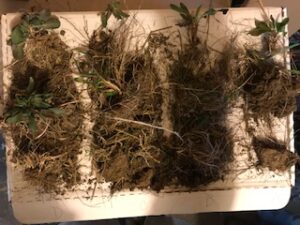
Root samples from the test strip; the control area is pictured on the right.
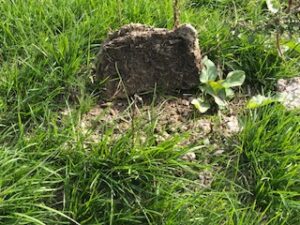
Overturned manure piles were noted in several of the treated areas.
Another assessment of the effect of the treatments may be in the production and health of the buffalo. In 2016 the weaned calf crop was 65% of the number of cows (17 out of 26 cows). In 2017 the weaned calf crop was 82% (23 calves from 28 cows). The number of live births in 2017 was 27 calves from 28 cows for a 96% calving rate, compared to 81% in 2016. The pounds of meat harvested in 2016 averaged 434.5 lb. / animal; in 2017 it averaged 457 lb. / animal. This was especially significant considering the harvest was a month earlier than usual. These increases may be attributable to more nutrient-dense forage contributing to better health of the animals. In 2016, twenty-four animals were harvested for a total hanging weight of 10,430 lb; in 2017 twenty-five animals were harvested for a total hanging weight of 11,425 lb. or 995 lb. more. At $4/lb. hanging weight, that is $3980 more meat harvested. With a retail value of about $12/lb. the increase in meat harvested is $11,940. The increased calf crop will mean more meat harvested in future years.
Educational & Outreach Activities
Participation Summary:
I plan to present my findings of this project at the Healthy Farms Conference to be held in Lincoln, NE Feb. 9&10, 2018.
If there is any visible differences in the various treatment areas by spring or summer 2018 I will contact the county extension agent about hosting a field day.
I sent a report to the company from which the GroBalance product was purchased at their request, for which we received a discount for advance purchase for 2018.
Learning Outcomes
We have learned a lot about soil assessments. The improved soil tilth and overturned manure piles were unexpected findings. We will definitely be continuing our observations in future years.
Project Outcomes
Conclusion: The purpose of this study was to compare the effect of applying a biological solution, sea minerals, or a combination of both on pasture production. After 2 years of applying these to defined areas of the pasture and leaving one area without any application, it is virtually impossible to say if there is a definite advantage to any one product over another. The cost of all 3 applications was similar when comparing the cost of making multiple trips to pick up raw milk. The combination product (GroPal Balance) was the most convenient. The biological solution (raw milk and fish emulsion) could be the most economical if a person had easy access to these products. The sea minerals (Sea 90) can also be given free-choice as a mineral supplement. All 3 showed a rapid improvement in organic matter and overall soil health. However, the control area also showed improvement. The additives probably contributed collectively to higher nutrient density of the grasses which contributed to the overall health of the grazers (buffalo, in this case).
Plan: We have purchased more of the GroPal Balance to put on the entire pasture next year. We also plan to continue the rotational grazing. We will probably continue using Sea 90 as free-choice mineral. We will also continue to observe any differences in the different areas of treatment.
This project has forced us to pay closer attention to the health of our soil, grasses, and animals through soil tests and observations. We plan to continue these observations and soil tests and evaluate the effect of soil amendments, rotational grazing, and other future practices. Thank you for funding projects such as these and for requiring the evaluations and reporting that go with them.